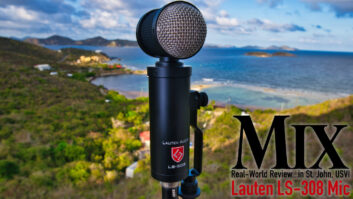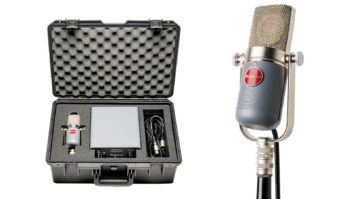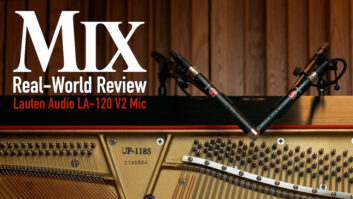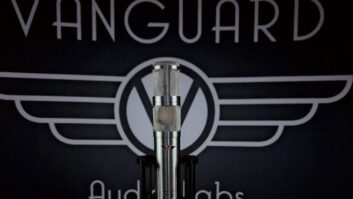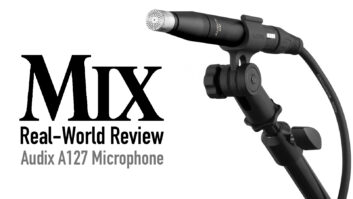The Lauten Oceanus is a unique specimen in that its unusual capsule is not only large, but it imparts a response that is significantly different from other large-diaphragm, multi-pattern tube microphones I’ve used.
I dub the Oceanus an ULDC (ultra-large-diaphragm condenser) with a superlative implication on the “ultra” part; I really like this mic’s unique tonality, even if it can be a bit “hit or miss” in application.
Features
The LT-381 employs a proprietary, dual 31.25mm diaphragm, edgeterminated (not the usual center) capsule along with a NOS military-grade pentode tube input stage, an unusual output stage (with a transistor phase splitter feeding a 12AU7 dual-triode tube, sans transformer); this “unique signal path eliminates the harshness often associated with transformer-less mics,” offers Lauten.
Oceanus’ two tubes are contained in an isolated chamber that usefully reduces interference and noise while effectively separating heat from the diaphragms, dissipating it via heat sinks, therefore encouraging consistency as well as longer life.
The Oceanus is fully accessorized for professional work with a rugged external power supply/pattern selector (cardioid, omni, figure-of-8 and six intermediate positions), a 7-pin Gotham cable, sustainably farmed wooden box, flight case and, most appreciated, the rarest of birds (or at least it seems rare these days): a shock mount that is sturdy enough to handle such a very heavy mic without slipping (sandbags for your stands are recommended).
In Use
Lauten’s descriptions are accurate: The essence of this mic is its fullness and smoothness. The top end is there, and it is extended, yet not overbearing or edgy as LDCs can be. Couple this with a bottom end that is substantial and very extended, and the result is more gentle and classy than anything. Surprisingly, the result is not sluggishness or muddiness (as one might expect from such a large diaphragm); I conjecture that the clarity of a transformer-less output, and those special circuit topologies contribute to the capsule’s voicing in a complementary and ultimately balanced manner.
I found that most male voices are handled wonderfully by the LT-381, with a lack of unwelcome sibilance, accuracy without stridency through the high-mids and a nice sense of “completeness” through the low-mids and lows; it is “complete-sounding” in that all low notes are well represented without peaks or dips in the response, giving the vocalist more perceived power and consistency. For louder parts and/or yells/screams, the Oceanus transitions from singing better than any vocal mic I’ve used, giving enough heft to aggressive parts and allowing me avoid EQ automation or split tracks. The intermediate pattern positions between omni and cardioid are quite useful, and figure-of-8 nicely handled two-voice BGVs without surprises.
Female voices are handled very nicely with the the LT-381, as all that classy smoothness is typically perfect for thinner-sounding sopranos, and the accuracy through the low-mids will flatter altos.
Conversely, I tried the Oceanus with a deep-voiced, chesty guy and it wasn’t a good match. In that application, the Oceanus was simply too large, too bassy and not defined enough (as was the vocalist, to be fair).
Acoustic instruments are often given useful substance by the LT-381. Tambourine in semi-omni worked very well, with plenty of thwack and no painful top end. Acoustic guitars are a matter of application and taste. With solo guitar as sound source, you will surely like the bigness, body and lack of top-end hype; if it’s part of an ensemble mix, the Oceanus will likely pick up more “chunk” than you need (though you can always whip out an aggressive HPF and sweeten the top with EQ). A super-quiet finger-picker found me with 60 dB of gain on the mic and a bit of noise floor apparent (some of it from my mic pre, to be sure), but that’s expected with tube-driven condensers.
I tried the Oceanus in a number of ambient drum kit positions such as distant room, nearby room and “butt mic” (generally a condenser just behind the drummer’s throne position) and received nicely balanced tones that were good on the top end, while calling out for a HPF based on position and taste. I can only imagine how nice a pair of these would sound on overheads (assuming you had the massive stands required to hold a pair of these up in the air).
I tried the Oceanus on djembe and found its response to be somewhat ribbon-like. Both the Oceanus and a ribbon for comparison’s sake picked up that somewhat hyped “Rubenesque” bottom that is usually just what I’m looking for. Also like a ribbon, I needed a little more top end to capture those all-important slaps and finger-rolls — and had to add an AKG C 451 to the take.
Summary
The djembe app highlighted to me the differences between this “ULDC” and a LDC more than any other: it’s as if the Oceanus splits the differences between a ribbon mic and a typical LDC … the LT-381 has more top than most ribbons, less top than a condenser and a smoothness of character right between the two.
Furthermore, the LT-381 has less bottom than most ribbons, more bottom than a typical condenser and a smoothness/fullness that is right in between the two.
I don’t mean to paint the Oceanus as a big, dark, heavy pony. This mic is extremely versatile with careful placement and filtering. The Oceanus may be unique in its voicing and its design, but it’s useful and capable across a wide range of inputs and apps. At $1,599 street, the Oceanus will be a great go-to mic for a wide range of engineers and budgets, too.
Price: $1,699 list
Contact: Lauten Audio | lautenaudio.com
Rob Tavaglione has owned and operated Catalyst Recording since 1995.
